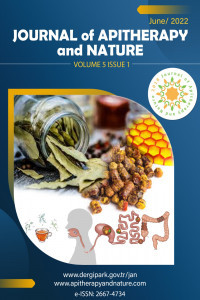Chemical Profile and Botanical Origin of Stingless Bee Propolis from Thailand and Indonesia
Chemical Profile and Botanical Origin of Stingless Bee Propolis from Thailand and Indonesia
___
- Ishizu E, Honda S, Vongsak B, Kumazawa S (2018) Identification of plant origin of propolis from Thailand stingless bees by comparative analysis. Natural Products Communications, in press.
- Yayın Aralığı: Yılda 2 Sayı
- Başlangıç: 2018
- Yayıncı: Oktay YILDIZ
Chemical Profile of Greek Arbutus unedo Honey – Biological Properties
αrgyrο ANDREOU, Ioanna CHINOU, Konstantia GRAIKOU
Fatty Acid Analysis and Biological Activity of Jordanian Propolis
Ashok K. SHAKYA, Shankar KATEKHAYE, Ghaleb A. ORIQUAT, Rajashri R. NAIK, Rajashri R. NAIK, Anant PARADKAR, Hugo FEARNLEY, James FEARNLEY
Isolated Xanthones from Lisotrigona furva Propolis in Vietnam
Le Nguyen THANH, Ha Thi THOA, Vu Thi Kim OANH, Diep Thi Lan PHUONG, Hoang Thi VAN, Nguyen Quynh CHI, Tran Huu GIAP, Nguyen Thi Tu OANH, Nguyen Thi Minh HANG, Nguyen Van HUNG, Chau Van MINH, Vassya BANKOVA
The Impact of Honeybee Origin on the Quality of Propolis
Gomes da Silva CAHANGO, Soraia I. FALCÃO, Miguel VILAS-BOAS
Cytotoxic Activity of Four Propolis Colombian Samples Against Canine Osteosarcoma Cells
Dolly Patricia Pardo MORA, Oscar Julián MURILLO, Mauricio Rey BUITRAGO, Mónica LOSADA, Jaime Fabian Cruz URIBE, Karina Basso SANTIAGO, Bruno José CONTI, José Maurício SFORCIN
Antimicrobial Effect of Commercial Propolis Extract (BEEO©)
Aslı Elif TANUGUR, Sevgi KOLAYLI, Merve KESKIN, Sengul ALPAY KARAOGLU
Hristo PETKOV, Boryana TRUSHEVA, Milena POPOVA, Vassya BANKOVA
In Vitro Evaluation of Green and Red Propolis Extracts Against Candida spp
M. D. FREITAS, G. A. LOPES, N. A OLIVEIRA, B. M. ALMEIDA, S. R. L. ABREU, R. C. BASQUES, N. S. BINDA, S. M. FIGUEIREDO
The Efficacy of Propolis Fluoride in Inhibiting Dental Caries Activity on Primary Teeth
Risqa Rina DARWITA, Iwany AMALLIAH, Sri Angky SOEKANTO, Muhamad SAHLAN
